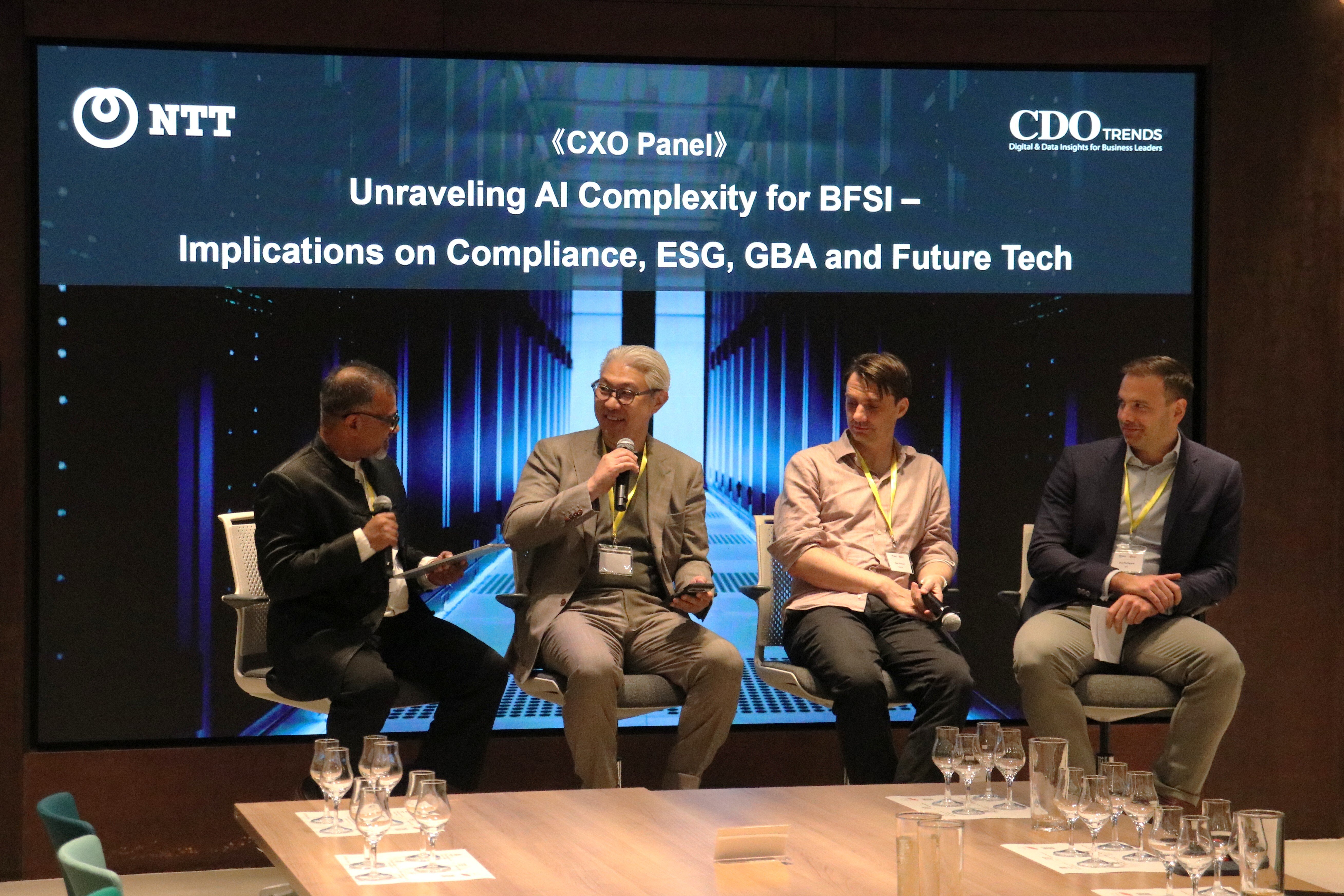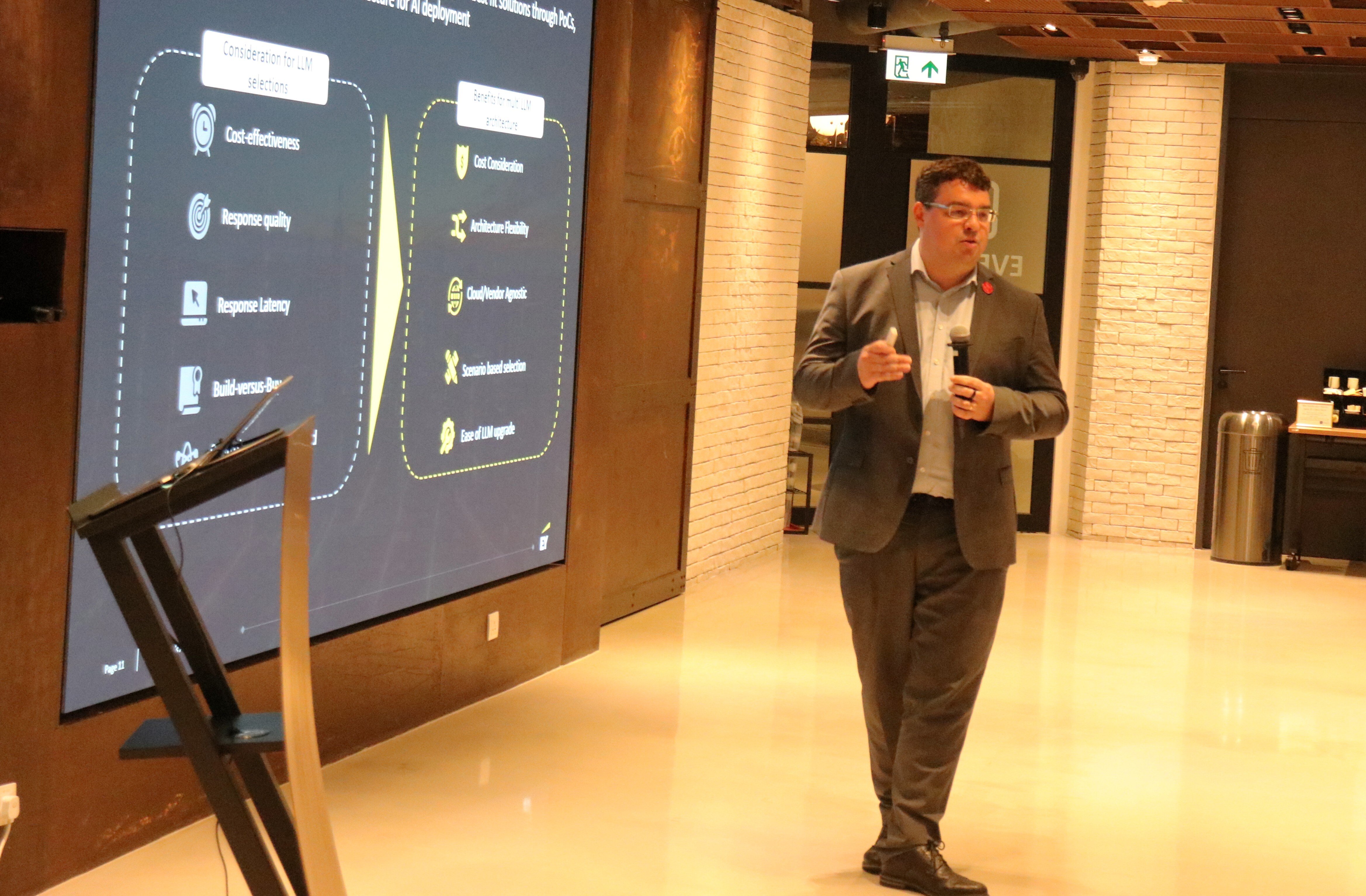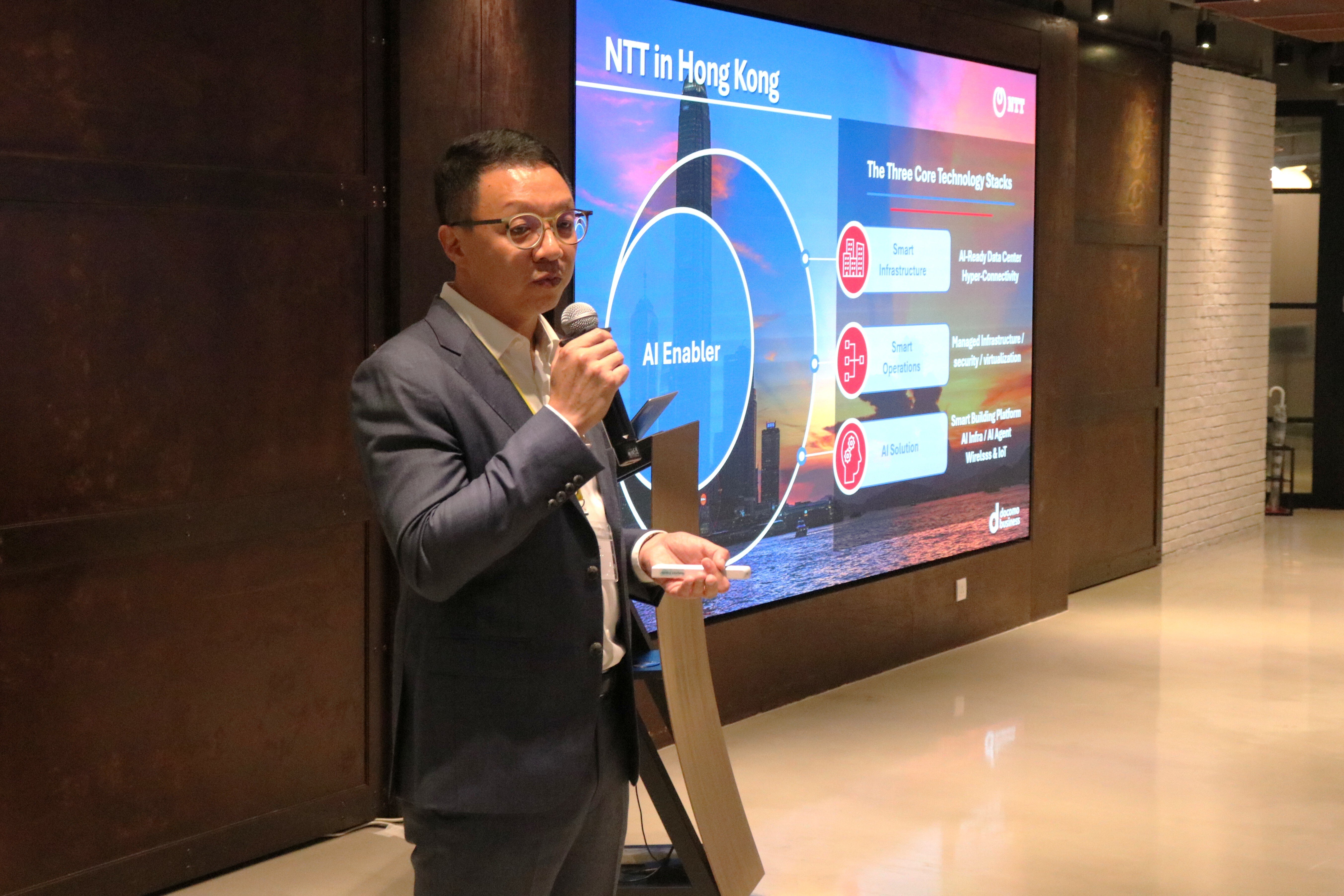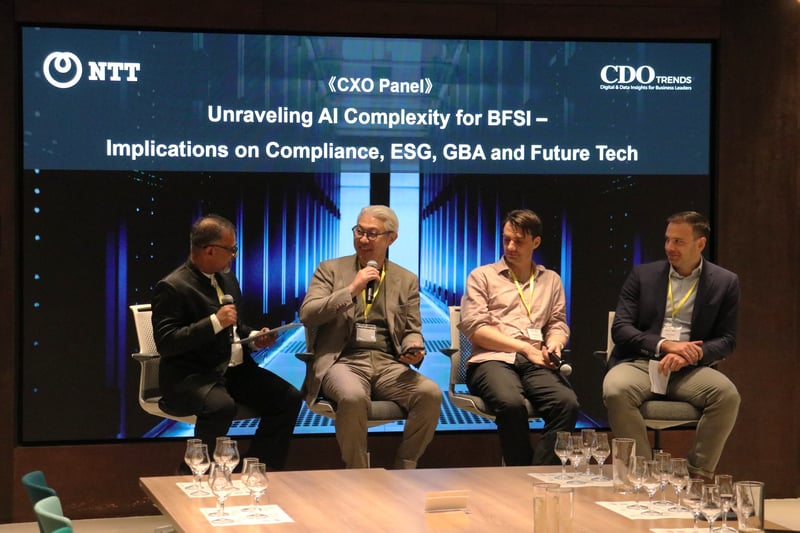Private 5G & IoT: The Power Duet Fuelling Hong Kong's Smart City Revolution
Abstract from NTT Innovation Summit’s panel discussion
“Orchestrating a New Era of Machine Interaction: The Duet of Private 5G & IoT”
30th October 2024
Don't just hear from human leaders,
challenge your mind with the perspectives of a social humanoid. Sophia, the HK-grown sensation, shares her unique insights on what truly fuels innovation.
Proofing the Future:
Hong Kong’s AI Infrastructure Race for FSIs
Insights from "Mastering AI Blueprint: Building AI-Driven Smart Digital Infrastructure" organized by NTT
Author: Winston Thomas, Editor-in-Chief, CDO Trends
Source: CDO Trends (28 July 2025)

The whiskey analogy wasn’t lost on anyone in the room. As Chris Barford, EY’s AI and data lead for financial services, Hong Kong, stood before Hong Kong’s technology elite at the recent event “Mastering AI Blueprint: Building AI-Driven Smart Digital Infrastructure”, he painted a picture that would make any distiller proud: “Selecting multiple LLMs is like a distillery deciding whether you’re going to do a beautiful single malt, or blend together and create a richer profile.”
But beneath this smooth metaphor lies a harsh reality. Hong Kong’s financial services sector is staring down a technological transformation so rapid and complex that traditional infrastructure approaches are crumbling faster than a poorly aged cask.
The data governance gauntlet
Barford’s opening salvo cut straight to the bone of Hong Kong’s unique challenges. “We have consumer patterns where people, particularly in the Greater China region, expect certain levels of data usage outside of Mainland China. There’s an interest in the ethical use of data. We have to protect that”, he explained, outlining the intricate dance between regulatory compliance and innovation that defines the Greater Bay Area’s AI landscape.
The complexity goes beyond regulatory. “The AI space is changing so rapidly, but at the same time, I can't always get access to the hardware I need to run it due to trade restrictions,” Barford noted, highlighting how geopolitical tensions are forcing a fundamental rethink of technology stacks.
The solution? What EY calls an “LLM agnostic architecture”. It is a framework designed to deploy multiple models while adapting to rapidly changing costs, quality, and regulatory requirements. “The models, costs and quality of the outcomes change so quickly that you need to be able to make changes”, Barford emphasized.
His most provocative insight centered on data governance evolution: “We failed to do customer 360 views ten years ago, and then five years ago. Now I think we’re getting to the point where we can use GPTs and generative AI to achieve a real, ‘perfect’ customer copy — maybe not at an individual customer level, but certainly as a cohort.”
Powering tomorrow’s data centers
If Barford outlined the challenges, Steven So, NTT’s new chief technology officer for Asia, delivered the infrastructure reality check. His presentation revealed numbers that would make any CIO’s head spin: AI factories consuming 40-50 megawatts each, with an individual GPU rack drawing over 80 kilowatts, nearly 20 times traditional enterprise consumption.
“Today, AI energy consumption is around 1.5% of global power consumption. Five years down the road, it will reach 3%," So projected, painting a picture of exponential growth that traditional power infrastructure simply cannot support.
So noted that companies like NTT are working to address the power challenge. While the industry is already discussing Small Modular Reactors (SMRs), he notes that this is something for the future.
The cooling revolution is equally dramatic. So demonstrated how NTT’s deployment of Direct Liquid Cooling (DLC) across its global data centers is already addressing these challenges. “The heat capacity of liquid is much better than air. When you’re using AI chipsets like Blackwell or later versions, this technology is essential.” NTT’s experience deploying DLC in India, the U.S., and Hong Kong positions them uniquely to handle the transition as GPU densities soar beyond 100 kilowatts per rack.

Chris Barford, Partner, Financial Services Consulting AI & Data Lead, EY Hong Kong
But So’s most ambitious vision centered on NTT’s IOWN (Innovative Optical and Wireless Network) initiative — a R&D ambition that could reshape digital infrastructure. “The idea is to converge photonic components with electronic circuits on a silicon platform - Silicon Photonic Convergence - that leverage the advantages of optical over electric signals, such as high bandwidth, low electromagnetic interference and better energy efficiency to improve the performance of digital infrastructure.”
Stage 1 of the IOWN initiative on All Photonic Network (APN) enables connectivity with much lower power consumption, higher bandwidth, and dramatically reduced latency, which is crucial for applications such as autonomous driving and high-frequency trading. “We’re anticipating much faster transmission capacity and much lower latency for tele-surgery, high-frequency trading, and autonomous driving,” So outlined, describing technology that could give Hong Kong a decisive edge in financial services.

Steven So, Chief Technology Officer, NTT Com Asia
The human-AI convergence
The panel discussion, the highlight of the event, revealed how organizations are implementing these revolutionary technologies. Owen Chong, vice president of overseas business at Xiaoice, offered perhaps the most tangible example of AI infrastructure at work through digital humans.
“Banks in China now automate the bank account opening process using an AI-assisted agent. When you visit their bank to open a new account, you’re not talking to a real person. You go into a private room with a digital human,” Chong explained, describing a future where AI interfaces become the primary customer touchpoint.
Phil McManus, director of business innovations from NTT, emphasized how their infrastructure evolution matches market demands: “There really isn’t a one-size-fits-all approach. We’re seeing demand, especially with FSI, for the ability to host models locally and run private AI models. There’s a very big demand for modular, scalable infrastructure.”
NTT's response has been comprehensive, from its 1,500 megawatts of operational data center capacity globally to its tier-one IP backbone services covering North America, Europe, India, and the APAC region. “We started experimenting with many models that were open, in the cloud, and only available at certain locations. Now we’re seeing demand for private AI models,” McManus noted, highlighting how NTT’s infrastructure flexibility addresses these evolving requirements.
Ryan Manuel, founder of Bilby AI and a former professor, delivered the session’s most provocative insight about AI’s true impact: “The problem is that AI is not suited to BFSI. You've got the most regulated industry, the lowest tolerance to error, and then you've got this field built largely on taking enormous amounts of data with enormous variety.”
His solution? Think beyond replacement. “It’s not about replacement cost — it’s about what we can make that couldn’t be made before. What is the coolest thing we can do that means more people come to your bank rather than your competitor?”
The infrastructure imperative
The convergence of these technologies — from IOWN’s photonic computing to private 5G networks — creates possibilities that seemed impossible just years ago. NTT’s bet on Private 5G as “the first provider licensed to do Private 5G solutions” demonstrates how infrastructure leaders are already positioning for mission-critical applications that Wi-Fi and traditional wireless cannot support.
Manuel’s closing observation cut to the heart of organizational transformation: “What AI is amazing at is going from zero to 95% immediately, but it will never get to 100%. So if you’re a BFSI, this is an amazing opportunity to think about what you’re actually better at — not what your marketing says you’re good at, but actually good at.”
McManus reinforced both the sustainability imperative and the infrastructure reality: “Regardless of whether we’re going to double our energy usage or it’s only going to be 1.5x, it’s still an important consideration. We have to invest in infrastructure that drives toward a more sustainable future.” With NTT’s commitment to achieving net zero by 2040 and its operational experience with integrating renewable energy, the company embodies the kind of long-term thinking necessary for sustainable AI infrastructure.

The Hong Kong advantage
For Hong Kong’s chief data officers and chief information officers, it’s clear that the infrastructure revolution is here. The city’s unique position as a bridge between East and West, combined with relatively flexible AI regulations, creates an unprecedented opportunity.
However, success requires partnerships with providers who have made the massive R&D investments necessary for next-generation infrastructure. NTT’s annual USD3 billion R&D spend across communications, photonics, and informatics, plus its 150-year history of infrastructure innovation, exemplifies the kind of long-term commitment required. Their deployment of advanced cooling technologies across global facilities, combined with IOWN’s promise of photonic computing, offers a glimpse of infrastructure that can support AI’s exponential growth.
The winners will be those who abandon traditional technology procurement cycles. As Barford warned: “A long time ago, we picked the best solution and stuck with it for 5-10 years. The AI space is changing too rapidly for that approach.”
Tomorrow’s FSI leaders will be those who build adaptable, sustainable infrastructure that can pivot between models, power sources, and regulatory requirements while maintaining the reliability that financial services demand. They’ll embrace photonic computing, new forms of power, and digital humans not as science fiction, but as business necessities.
The whiskey analogy proves prescient: like master distillers, Hong Kong’s technology leaders must blend multiple elements — LLMs, power systems, cooling technologies, and human interfaces — into something richer and more sophisticated than any single component could achieve alone. The only question is who will pour the first glass.
